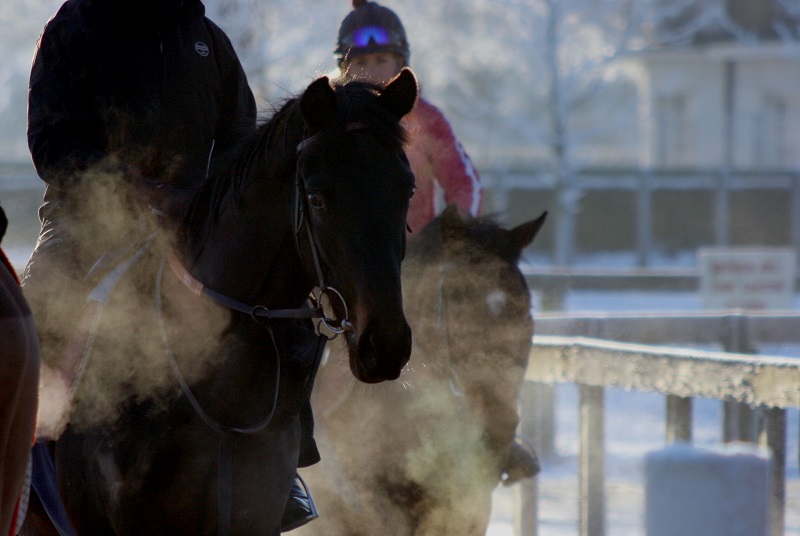Posted: 6th February 2018 | Back to news feed

It’s Winter. It’s supposed to be cold. And it looks as though the next week the UK will see a marked drop in temperatures to around -10 to 5°C and possibly more snow if the forecasts are accurate. But should this have any influence on how and when we ride our horses? If you are a Yakutian or Yakut horse in Siberia used to living at -50°C in Winter then next week in the UK would probably be equivalent to a warm Spring day. But then these horses aren’t in regular daily training.

So what are the possible risks for our horses with a sudden dip in the mercury and are there any steps you can take to avoid problems?
Warming-Up
Not surprisingly it takes your horse longer to warm-up in cold weather. If muscles, ligaments and tendons (soft-tissues) are not adequately warmed-up before faster or harder work (e.g. jumping) then this can increase the risk of injury. This is easily managed though – either allow longer at walk and trot before moving into faster/harder work and or exercise with a quarter blanket to increase the speed at which the body warms up.
Orthopaedic Injury
A major risk factor for injury is exercising on uneven surfaces and surfaces that change suddenly over a short distance from soft to hard or vice versa. Surfaces (natural and synthetic) are most likely to be adversely affected by low temperatures early in the morning, especially areas that do not get early sunlight on them. These can stay frozen all day in cold spells. For horses with degenerative type conditions such as arthritis, hard and uneven ground can be “jarring” and combined with low temperatures can lead to increased stiffness and unsoundness.
Respiratory Health
Many people will be familiar with the fact that human asthma is worse in cold weather. Just before last Christmas Asthma UK estimated that 4 million people in the UK (around 75% of total asthmatics) would be at risk of life-threatening attacks due to breathing in cold air due to the sudden drop in temperatures. The advice given was to avoid exercise in the cold and to wear a scarf over the nose and mouth to help warm and humidify the inspired air. The effect of cold-air on human athletes is also well recognised, particularly in ice-hockey players and cross-country skiers, where it is referred to as “ski-asthma”.
Horses are also commonly affected by asthma (often referred to as IAD/RAO/equine COPD/heaves). This is predominantly related to breathing in allergens (moulds, pollen, dust, etc) which lead to an inflammatory reaction, production of mucus and narrowing of the airways. However cold air acts in a different way and leads to the same effects but without involvement of allergens through irritation of the nerves in the airways. We have previously demonstrated that damage occurs to the airways in “healthy” horses during a slow canter breathing air around 5°C as well as during galloping. In addition, a study from North America showed that the number of Standardbred racehorses with blood in the airways after exercise increased as the air temperature dropped.
Whilst scarves may work for people and whilst some cold weather masks have been tried for horses, these are not considered to be effective.
Energy & Feed
During cold-weather horses use more energy to keep warm, particularly as air temperatures remain close to freezing. However, for a period of a week it would not be necessary or even desirable to increase a horses feed intake provided they have free access to moderate to high quality forage. Cold-weather exercise also increases the amount of glycogen that is used as an energy source as adrenaline levels are higher in cold weather and adrenaline increases glycogen use. This could mean a slight decrease in performance or a slightly decreased capacity for exercise but this would not be noticeable for the majority of horses. The biggest risk for energy intake causing problems for horses during cold spells is when horses cannot be exercised as normal but feed intake is maintained. For horses that are on overweight, laminitic prone or prone to tying-up, this can push them over the edge. Therefore, if you have to decrease work due to cold weather then also cut the hard feed back as well.
TOP TIPS FOR COLD WEATHER TRAINING & MANAGEMENT
* Spend more time at walk and trot when warming up
* Avoid moderate to hard exercise early in the morning or on very cold days, especially for horses with a tendency to respiratory disease
* Avoid hard uneven ground, such as in areas of an arena or track that do not get sunlight in the morning as these can stay hard and be a major risk for injury
* If you have to reduce daily exercise due to frozen or hard surfaces, then cut-back any hard feed, especially for laminitis and or tying-up prone horses
* This applies to all horses in work, not just racehorses or high-performance sport horses
REFERENCES
Cold weather puts 4 million people with asthma at risk as temperatures plummet https://www.asthma.org.uk/…/press-release-cold-weather-put…/
Davis MS, Royer CM, McKenzie EC, Williamson KK, Payton M, Marlin D. Cold air-induced late-phase bronchoconstriction in horses. Equine Vet J Suppl. 2006 Aug;(36):535-9.
https://www.ncbi.nlm.nih.gov/pubmed/17402479
Davis MS, Lockard AJ, Marlin DJ, Freed AN. Airway cooling and mucosal injury during cold weather exercise. Equine Vet J Suppl. 2002 Sep;(34):413-6.
https://www.ncbi.nlm.nih.gov/pubmed/12405726
Murray RC, Walters J, Snart H, Dyson S, Parkin T. How do features of dressage arenas influence training surface properties which are potentially associated with lameness? Vet J. 2010 Nov;186(2):172-9.
https://www.ncbi.nlm.nih.gov/pubmed/20888276
Crispe EJ, Lester GD, Robertson ID, Secombe CJ. Bar shoes and ambient temperature are risk factors for exercise-induced pulmonary haemorrhage in Thoroughbred racehorses. Equine Vet J. 2016 Jul;48(4):438-41.
https://www.ncbi.nlm.nih.gov/pubmed/25962341
Hinchcliff KW, Morley PS, Jackson MA, Brown JA, Dredge AF, O'Callaghan PA, McCaffrey JP, Slocombe RF, Clarke AF. Risk factors for exercise-induced pulmonary haemorrhage in Thoroughbred racehorses. Equine Vet J Suppl. 2010 Nov;(38):228-34.
https://www.ncbi.nlm.nih.gov/pubmed/21059011
Lapointe JM, Vrins A, McCarvill E. A survey of exercise-induced pulmonary haemorrhage in Quebec standardbred racehorses. Equine Vet J. 1994 Nov;26(6):482-5.
https://www.ncbi.nlm.nih.gov/pubmed/7889923
The Equestrian Index newsfeed is compiled from articles submitted by advertising members and expresses the opinions of those members. Watsons Directories Ltd shall not be held liable for any inaccuracies or mis-statements therein.
